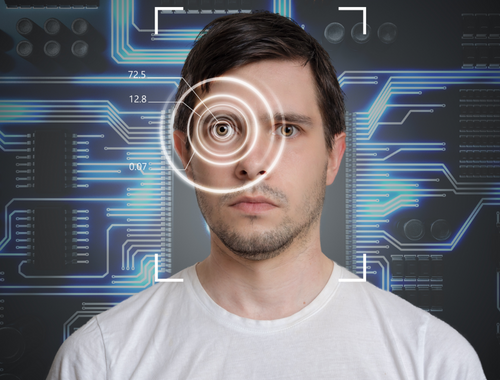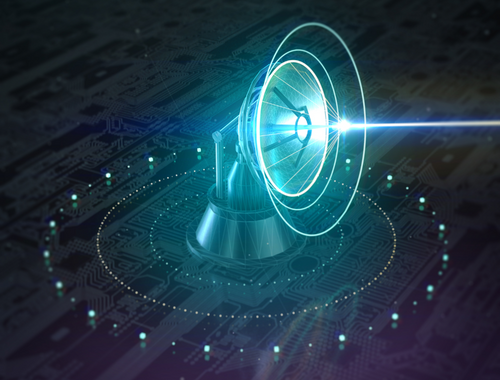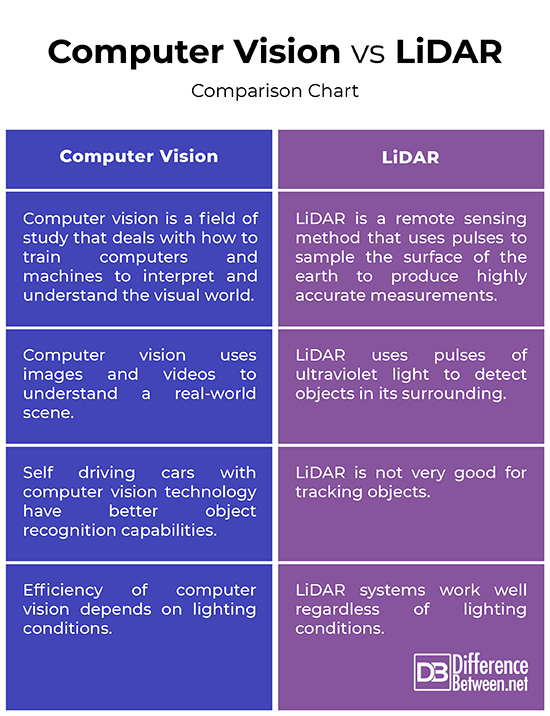Difference Between Computer Vision and LiDAR
The last two decades have seen a rapid rise in the applications of light detection and ranging (LiDAR) in various fields, more so in the automotive industry, particularly in the development of self-driving cars. But there are some autonomous cars that use computer vision. Tesla, for one, uses computer vision on its self driving cars, going against LiDAR sensors. Let’s take a look how the two competing technologies stack up against each other.

What is Computer Vision?
Computer vision is a field of study that deals with how to train computers and machines to interpret and understand the visual world. Computer vision uses images and videos to understand a real-world scene; it goes beyond image processing which can remove noise or blur and identify objects based on size, color or location. The goal of computer vision is to extract useful information from images. Computer vision is a subfield of Deep Learning and Artificial Intelligence where humans teach computers to interpret and understand digital images or videos using AI based on neural networks, machine learning and deep learning methodologies. Computer vision methods can identify, track, measure, detect, and classify objects and images and videos. The idea is to get algorithms to understand image content in the same way the human brain does.

What is LiDAR?
LiDAR, short for Light Detection and Ranging, is a remote sensing method that uses light in the form of pulsed laser to sample the surface of the earth to produce highly accurate measurements. The LiDAR system sends a pulse of light and waits for the pulse to return, and measures how long it takes for the emitted pulse to return back to the sensor. Like sonar waves use sound waves to map things, radar uses radio waves, and LiDAR uses light sent out from a laser, offering precise 3D data over short to long ranges. It’s essentially a giant laser ranging device that sends out millions of pulses per second. These pulses bounce off objects and return back to the sensor, which then uses the time it takes each pulse to return to calculate the distance or the range to the target.
Difference between Computer Vision and LiDAR
Definition
– Computer vision is a subfield of Deep Learning and Artificial Intelligence where humans teach computers to interpret and understand digital images or videos using AI based on neural networks, machine learning and deep learning methodologies. LiDAR, short for Light Detection and Ranging, is a remote sensing method that uses light in the form of pulsed laser to sample the surface of the earth to produce highly accurate measurements.
Technology
– Computer vision uses images and videos to understand a real-world scene in order to create a 3D map, which enables self-driving cars to identify, classify, and detect different objects. The idea is to find lane lines on the road and obstacles, and compute the steering angle. LiDAR uses pulses of ultraviolet light to detect objects in its surrounding. These pulses bounce off objects and return back to the sensor, which then uses the time it takes each pulse to return to calculate the distance or the range to the target.
Object Recognition
– LiDAR uses laser light that sends out millions of pulses per second going and hitting objects and reflecting back, providing excellent range information. So, the distance measurement and the depth perception are better than what cameras can do. But self driving cars based on computer vision technology have better object recognition capabilities, but do not provide high resolution range information. Cameras see colors and hence can detect and track objects better whereas LiDAR is not very good for tracking objects.
Computer Vision vs. LiDAR: Comparison Chart

Summary
Like we need our senses to see things, a self driving car needs something to detect its surroundings. There are many ways self driving cars can detect the objects around them; for example they can use cameras, radar, and radios to survive. Computer vision uses images and videos to understand its surroundings while LiDAR uses light in the form of pulsed laser to estimate accurate localization of objects in 3D space. Computer vision technology for localization is not that accurate because distance measurement and the depth perception are not very good. Computer vision cannot function well in bad lighting conditions as well.
Is LiDAR better than vision?
Both the approaches have their fair share of pros and cons. For example, LiDAR uses light in the form of pulsed laser to estimate accurate localization of objects in 3D space whereas distance measurement and depth perception with computer vision are not very good. LiDAR is not very good for tracking objects.
Why is Tesla against LiDAR?
While LiDAR can track objects with much higher precision, Elon Musk thinks LiDAR is unnecessary and the cost of placing a single LiDAR device on a car is significantly higher. The cost is probably the most apparent reason Tesla took the different route.
What does Elon Musk think of LiDAR?
Elon Musk said, “LiDAR is a fool’s errand. Anyone relying on LiDAR is doomed.” He believed that the technology itself is very expensive and unnecessary.
Why LiDAR is doomed?
LiDAR almost works well in all weather conditions, but self driving cars with LiDAR technology cannot see in fog, dust, rain or snow. It can only detect the presence or absence of matter because it is a binary sensor.
Why does Elon Musk not believe in LiDAR?
Tesla has been heavily relying on computer vision and going against the LiDAR technology. The most apparent reason Tesla took the different route is the cost. The overall cost becomes significant.
Is LiDAR the future?
LiDAR is one of the leading candidates to transform the landscape of self driving vehicles. But whether it’s going to be the future of autonomous vehicles, there’s no easy to answer to that.
- Difference Between Caucus and Primary - June 18, 2024
- Difference Between PPO and POS - May 30, 2024
- Difference Between RFID and NFC - May 28, 2024
Search DifferenceBetween.net :
Leave a Response
References :
[0]Dong, Pinliang and Qi Chen. LiDAR Remote Sensing and Applications. Florida, United States: CRC Press, 2017. Print
[1]Mensah, Francis Emmanuel. Lidar Techniques and Remote Sensing in the Atmosphere: Understanding the Use of Laser Light in the Atmosphere. Indiana, United States: AuthorHouse, 2009. Print
[2]Prince, Simon J.D. Computer Vision: Models, Learning, and Inference. Cambridge, United Kingdom: Cambridge University Press, 2012. Print
